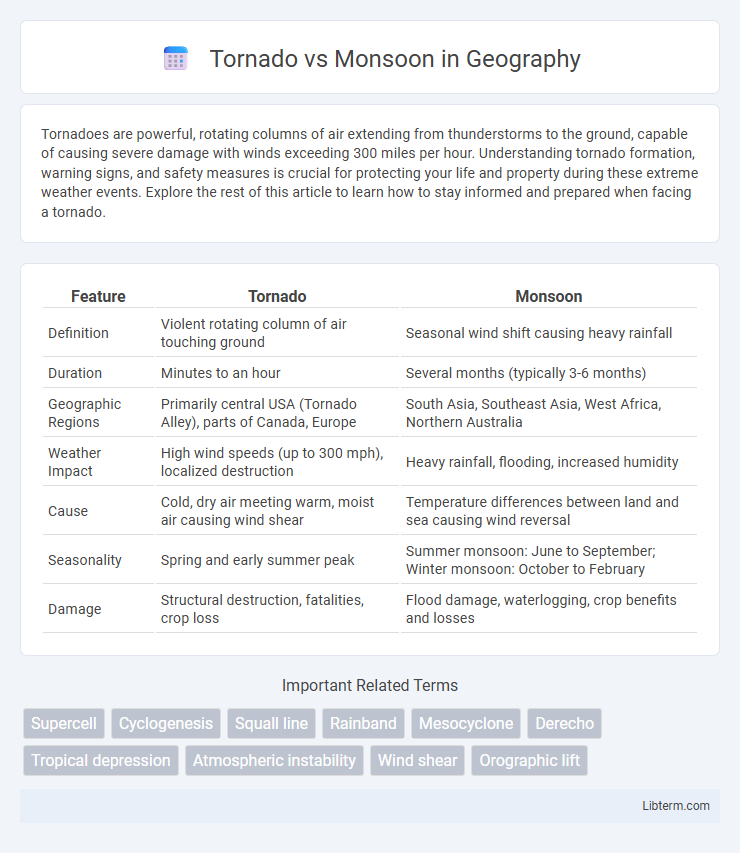Tornadoes are powerful, rotating columns of air extending from thunderstorms to the ground, capable of causing severe damage with winds exceeding 300 miles per hour. Understanding tornado formation, warning signs, and safety measures is crucial for protecting your life and property during these extreme weather events. Explore the rest of this article to learn how to stay informed and prepared when facing a tornado.
Table of Comparison
| Feature | Tornado | Monsoon |
|---|---|---|
| Definition | Violent rotating column of air touching ground | Seasonal wind shift causing heavy rainfall |
| Duration | Minutes to an hour | Several months (typically 3-6 months) |
| Geographic Regions | Primarily central USA (Tornado Alley), parts of Canada, Europe | South Asia, Southeast Asia, West Africa, Northern Australia |
| Weather Impact | High wind speeds (up to 300 mph), localized destruction | Heavy rainfall, flooding, increased humidity |
| Cause | Cold, dry air meeting warm, moist air causing wind shear | Temperature differences between land and sea causing wind reversal |
| Seasonality | Spring and early summer peak | Summer monsoon: June to September; Winter monsoon: October to February |
| Damage | Structural destruction, fatalities, crop loss | Flood damage, waterlogging, crop benefits and losses |
Understanding Tornadoes: Definition and Characteristics
Tornadoes are violently rotating columns of air extending from a thunderstorm to the ground, characterized by their funnel-shaped cloud and high wind speeds exceeding 300 mph. They are localized, short-lived, and often cause intense damage within a narrow path, typically a few hundred yards wide and several miles long. Tornado formation is driven by severe weather conditions, including supercell thunderstorms, significant wind shear, and atmospheric instability.
What is a Monsoon? Key Features Explained
A monsoon is a seasonal wind pattern characterized by a marked change in wind direction, causing distinct wet and dry seasons primarily in South Asia and parts of Africa. Key features of monsoons include prolonged periods of heavy rainfall during the wet phase, which significantly impacts agriculture, water resources, and the overall climate of affected regions. Unlike tornadoes, monsoons are large-scale meteorological phenomena driven by differential heating between land and ocean, resulting in sustained weather changes over several months.
Formation: How Tornadoes and Monsoons Develop
Tornadoes form from severe thunderstorms when warm, moist air clashes with cold, dry air, creating intense updrafts and rapidly rotating columns of air called mesocyclones. Monsoons develop due to seasonal shifts in wind patterns driven by temperature differences between land and ocean, causing prolonged heavy rainfall as moist air moves inland. Both phenomena rely on atmospheric conditions that generate significant airflow and moisture but differ in scale and duration, with tornadoes occurring rapidly and monsoons evolving over months.
Geographical Occurrence: Where Tornadoes and Monsoons Strike
Tornadoes primarily occur in the central United States, especially in Tornado Alley, where atmospheric instability and wind shear create ideal conditions for their formation. Monsoons affect regions like South Asia, including India and Bangladesh, where seasonal wind shifts bring heavy rainfall. These distinct geographical occurrences highlight how tornadoes are localized, severe weather events, while monsoons are extensive seasonal climate patterns.
Duration and Seasonality: Tornado vs Monsoon
Tornadoes typically last from a few seconds to over an hour, with most enduring less than 10 minutes, and are most frequent during spring and early summer. Monsoons persist for several months, usually spanning from June to September in South Asia, bringing prolonged seasonal rainfall. The stark contrast in duration and seasonality highlights tornadoes as short-lived, highly localized events, whereas monsoons represent extended, seasonal weather patterns.
Impacts on Human Life and Infrastructure
Tornadoes cause sudden, severe damage through high-velocity winds that destroy buildings, uproot trees, and pose immediate threats to human safety with flying debris and structural collapses. Monsoons lead to prolonged flooding, waterlogging, and landslides, resulting in widespread displacement, waterborne diseases, and infrastructure damage such as road erosion and collapsed bridges. Both weather events disrupt power supply, transportation networks, and healthcare services, but tornadoes create more localized, intense destruction while monsoons affect larger regions over extended periods.
Warning Systems and Preparedness
Tornado warning systems rely on Doppler radar technology and storm spotters to detect rapidly forming funnel clouds, providing residents with minutes to seek shelter. Monsoon preparedness focuses on long-term weather forecasting and flood monitoring to manage prolonged heavy rainfall and mitigate risks such as landslides and urban flooding. Effective warning dissemination through sirens, mobile alerts, and community drills enhances safety measures for both tornado and monsoon-prone regions.
Historical Events: Notable Tornadoes and Monsoons
The 1925 Tri-State Tornado remains one of the deadliest tornadoes in U.S. history, causing over 690 fatalities and widespread devastation across Missouri, Illinois, and Indiana. The Indian Monsoon of 2018 brought unprecedented rainfall, triggering severe flooding and affecting over 1,200 deaths, showcasing the monsoon's critical impact on agriculture and human life. Both phenomena have shaped regional disaster preparedness strategies due to their historical significance and recurring patterns.
Climate Change: Effects on Tornadoes and Monsoons
Climate change intensifies tornado activity by increasing atmospheric instability and moisture, leading to more frequent and severe tornado outbreaks in affected regions. Warmer ocean temperatures and altered atmospheric circulation patterns influence monsoon systems, causing shifts in the timing, duration, and intensity of rainfall that affect millions of people dependent on monsoon agriculture. Both phenomena are exacerbated by global warming, highlighting the need for improved climate resilience and adaptive strategies in vulnerable areas.
Tornado vs Monsoon: Key Differences Summarized
Tornadoes are intense, rapidly rotating columns of air extending from thunderstorms to the ground, characterized by high wind speeds exceeding 300 mph and lasting only minutes, whereas monsoons are large-scale seasonal wind patterns causing prolonged heavy rainfall and flooding over months. Tornadoes typically form during severe thunderstorms in localized areas, while monsoons affect entire regions, such as South Asia, influencing climate and agriculture significantly. The key differences involve scale, duration, wind speed, and impact, with tornadoes causing sudden, short-lived destruction and monsoons driving extended weather and environmental changes.
Tornado Infographic

 libterm.com
libterm.com